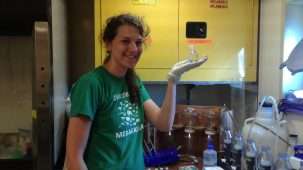Eavesdropping on the ocean's mighty microorganisms

The microscopic organisms that make up ocean ecosystems are invisible to the naked eye, yet they are responsible for producing half the oxygen we breathe, and for sustaining all the world's fisheries. Now, nearing the end of our three-week cruise of the North Pacific off Hawaii, we are working to understand how these tiny bacteria connect and communicate with one another.
We know bacteria have the ability to sense and respond to an unknown number of chemical signals, but we think it may be tens to hundreds. A few signals we know from lab experiments include quorum sensing molecules. Quorum sensing molecules are released by other bacteria to change the way cells behave when they have reached a sufficient density, or quorum. We know from previous work in the Dyhrman lab and the Van Mooy lab that quorum signaling is important in the bacteria communities that surround a particularly large and important
cyanobacterium, Trichodesmium. Tricho, as it is affectionately referred to, fixes large quantities of nitrogen fertilizer directly from nitrogen gas. The bacteria surrounding Tricho, or its microbiome can greatly affect the rates of nitrogen fixation in ways we do not yet fully understand. Nitrogen fixation is one of the most important biochemical processes on earth and in the oceans. In ocean ecosystems, it enables microorganisms to grow even when other nutrients, such as nitrate and ammonium, are scarce.
We would like to understand which bacteria are actively recruited to colonize Tricho and other large cells, and how chemical signaling impacts this process. To do this, we created a trap for bacteria using new techniques pioneered by our collaborator Otto Cordero. From scratch, we made microscopic beads embedded with phytoplankton cell extract and magnetic particles that allow us to pull the beads out of solution, separating them from the seawater and free-living cells. Inside the bottle I'm holding (see photo) are thousands of these tiny beads mixed with ocean bacteria. Over the past few weeks, we have mixed natural bacteria found in the surface ocean with different mixtures of chemical signals and phytoplankton-flavored beads. After we take our samples back to the lab, we can use DNA sequencing as a kind of universal barcode to identify the bacteria caught in our trap.
I can't wait to see what we will discover from these experiments, which give us new tools to eavesdrop on the conversation among marine bacteria. Understanding how bacteria communicate through signals is an important challenge for predicting the future of the ocean's complex microbial ecosystem.
Provided by State of the Planet
This story is republished courtesy of Earth Institute, Columbia University blogs.ei.columbia.edu .



















